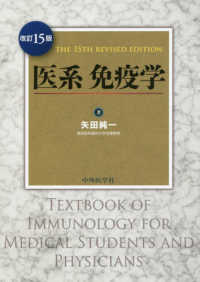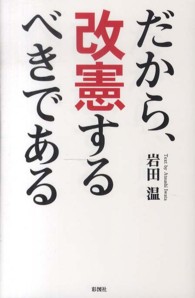- ホーム
- > 洋書
- > 英文書
- > Science / Mathematics
Full Description
Exam board: OCR
Level: A-level
Subject: Design and Technology
First teaching: September 2015
First exams: Summer 2016
Inspire your students to tackle the iterative design process with creativity and confidence, using a textbook that delivers the knowledge, understanding and skills they need for the 2017 OCR Design & Technology AS and A-level specifications.
Our trusted author team help you to confidently navigate both the designing and technical principles at the heart of OCR's enquiry approach and to apply them to each of the Product Design, Fashion and Textiles and Design Engineering endorsed titles.
- Supports co-teaching of AS and A Level with clear signposting to the additional knowledge, understanding and skills needed at A Level
- Inspires your students as they undertake the iterative design process, with a look at how to approach the Non-Exam Assessments, including creative examples of students' work for both the Product Development at AS and the Iterative Design Project at A Level
- Helps students to prepare for the written exams with practice questions and guidance on the 'Principles' papers at both AS and A Level, and the 'Problem Solving' papers at A Level
Contents
1: Identifying requirements
1.1: What can be learnt by exploring contexts that design solutions are intended for?
1.2: What can be learnt by undertaking stakeholder analysis?
1.3: How can usability be considered when designing prototypes?
2: Learning from existing products
2.1: Why is it important to analyse and evaluate products as part of the design and manufacturing process?
2.2: Why is it important to understand technological developments?
2.3: Why is it important to understand both past and present developments?
2.4: What can be learnt by examining the lifecycles of products?
3: Implications of wider issues
3.1: What factors need to be considered whilst investigation design possibilities?
3.2: What factors need to be considered when developing design solutions?
3.3: What factors need to be considered when manufacturing products?
3.4: What factors need to be considered when distributing products to markets?
3.5: How can skills and knowledge from other subject areas, including mathematics and science, inform decisions?
4: Design thinking and communication
4.1: How do designers use annotated 2D and 3D sketching and digital tools to graphically communicate ideas?
4.2: How do industry professionals use digital design tools to support and communicate the exploration, innovation and development of design ideas?
5: Material and component considerations
5.1: What factors influence the selection of materials that are used in products?
5.2: What materials and components should be selected when designing and manufacturing products and prototypes?
5.3: Why is it important to consider the properties/characteristics of materials when designing and manufacturing products?
6: Technical understanding
6.1: What considerations need to be made about the structural integrity of a design solution?
6.2: How can products be designed to function effectively within their surroundings?
6.2: (Design Engineering) How do mechanisms provide functionality to products and systems?
6.3: What opportunities are there through using smart and modern technologies within products?
6.3: (Design Engineering) What forces need consideration to ensure structural and mechanical efficiency?
6.4: (Design Engineering) How can electronic systems offer functionality to design solutions?
6.5: (Design Engineering) How can programmable devices and smart technologies provide functionality in system design?
7: Manufacturing processes and techniques
7.1: How can materials and processes be used to make iterative models?
7.2: How can materials and processes be used to make final prototypes?
7.3: How can materials and processes be used to make commercial products?
7.4: How is manufacturing organised and managed for different scales of production? 7.5: How is the quality of products controlled through manufacture?
8: Viability of design solutions
8.1: How can designers assess whether a design solution meets its stakeholder requirements?
8.2: How do designers and manufacturers determine whether design solutions are commercially viable?
9: Health and safety
9.1: How can safety be ensured when working with materials in a workshop environment?
9.2: What are the implications of health and safety legislation on product manufacture?
10: Preparing for non-exam assessment
10.1: Product development (AS)
10.2: Iterative design project (A Level)
11: Preparing for the written exam papers
11.1: Written Paper 01: Principles of Design Engineering, Fashion and Textiles or Product Design (AS)
11.2: Written Paper 01: Principles of Design Engineering, Fashion and Textiles or Product Design (A Level)
11.3: Written Paper 02: Unseen Challenge (A Level)








